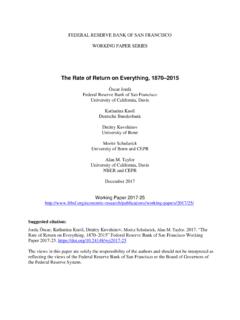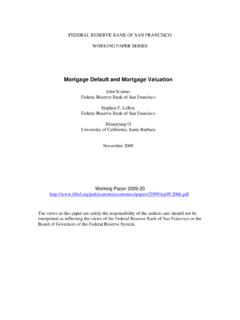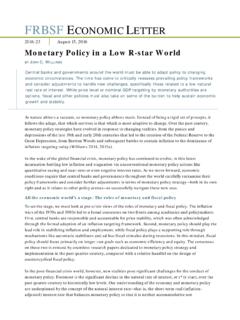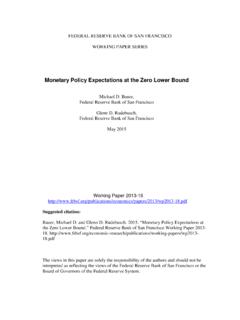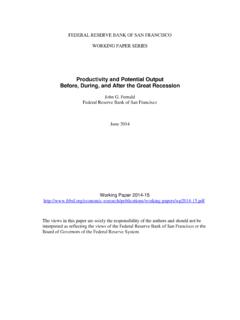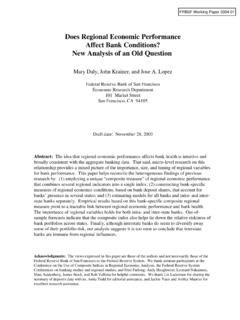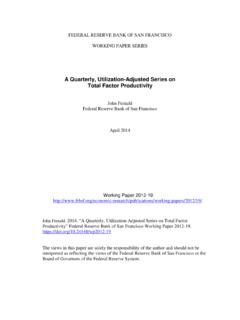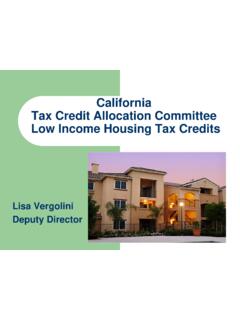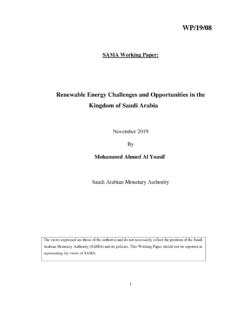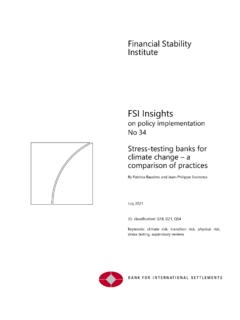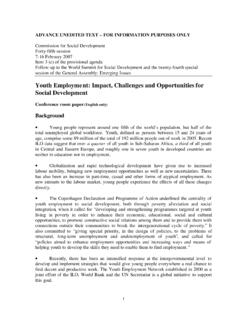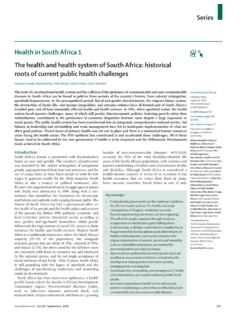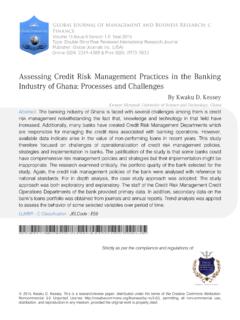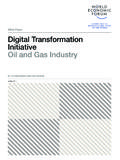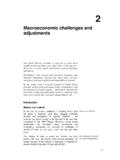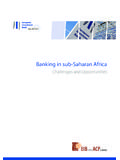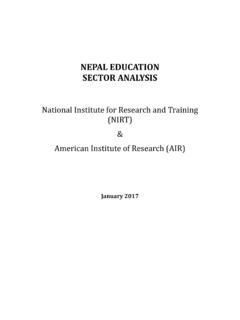Transcription of Climate change: Macroeconomic impact and implications …
1 1 Climate change : Macroeconomic impact and implications for monetary policy (Book chapter in: Ecological, Societal, and Technological Risks and the Financial Sector; forthcoming: July 2020) Sandra Batten, Rhiannon Sowerbutts and Misa Tanaka Bank of England1 Abstract Climate change and policies to mitigate it could affect a central bank s ability to meet its monetary stability objectives. Climate change can affect the macroeconomy both through gradual warming and the associated Climate changes ( total seasonal rainfall and sea level increased) and through increased frequency, severity and correlation of extreme weather events (physical risks). Inflationary pressures might arise from a decline in the national and international supply of commodities or from productivity shocks caused by weather-related events such as droughts, floods, storms and sea level rises.
2 These events can potentially result in large financial losses, lower wealth and lower GDP. An abrupt tightening of carbon emission policies could also lead to a negative Macroeconomic supply shock (transition risks). This chapter reviews the channels through which Climate risks can affect central banks monetary policy objectives, and possible policy responses. Approaches to incorporate Climate change in central bank modelling are also discussed. Contents Introduction: Why central banks care about Climate change .. 2 1. Climate change risks .. 3 2. Climate change and the macroeconomy: the transmission channels .. 4 3. implications of Climate change for monetary policy a summary .. 6 4. Physical risks, Macroeconomic impacts and implications for monetary 6 5. Transition risks, Macroeconomic impacts and monetary policy.
3 11 6. implications for the analytical framework of monetary policy authorities .. 13 7. Interactions between Macroeconomic and financial Climate shocks .. 15 Conclusion .. 16 1 The views expressed in this paper are those of the authors, and not necessarily those of the Bank of England or its committees. We are grateful to Jenny Lam and Andre Moreira for help and to Ryan Barrett and Theresa Lober for helpful suggestions. All remaining errors are solely the authors . 2 Introduction: Why central banks care about Climate change Central banks across the world have been increasingly paying attention to Climate change , having to acknowledge that it could affect their ability to meet their monetary and financial stability objectives.
4 Climate change also poses economy-wide and societal challenges , which inevitably require the financial system to take a central role in managing Climate risks and financing the carbon transition. The Bank of England was the pioneer among central banks in the assessment of the Climate risks for central banks: from understanding the impact of Climate change on the insurance industry (Bank of England 2015), the banking sector (Bank of England 2018) and the wider central bank objectives (Carney 2015; Batten et al. 2016, 2018) to devising a response to these challenges (Scott et al. 2017). Many other central banks and financial supervisors are now involved in Climate change initiatives. For example, central banks and financial regulators and supervisors have supported the initiatives by the Financial Stability Board to establish the Task Force for Climate -related Financial Disclosures (TCFD), in order to help improve disclosure of Climate -related risks by firms (TCFD 2018).
5 In 2017, central banks and supervisors have also established the Network for Greening the Financial System (NGFS) to help strengthening the global response required to meet the goals of the Paris Agreement and to enhance the role of the financial system to manage risks and to mobilize capital for green and low-carbon investments (NGFS 2019). As of March 2019, the Network included 30 members and five observers across five And in early 2019, a group of US Senators have written to the Chairman of the Federal Reserve Powell urging him to ensure that the US financial system is prepared for the risks associated with Climate change and requesting information on the steps the Fed has taken to identify and manage Climate related risks in the financial system (US Senate 2019).
6 Soon after that, Rudebusch (2019) published an article examining the implications of Climate change on the Federal Reserve. This chapter focuses on the impact of Climate change on central banks monetary policy objective of maintaining low and stable inflation. For most central banks, price stability is usually the primary monetary policy objective, while some have output stability as an additional or a secondary objective. For example, the Bank of England s monetary policy objective is to maintain price stability within the United Kingdom and subject to that, to support the economic policy of Her Majesty s Government, including its objectives for growth and employment. The US Federal Reserve s mandate includes three goals of equal priority: maximum employment, stable prices, and moderate long-term interest rates in the economy.
7 The single monetary policy objective of the Euro system the European Central Bank (ECB) and the national central banks of the euro area countries is to maintain price stability. 2 The NFGS s First comprehensive report was published in April 2019 (NFGS 2019). 3 The chapter is organised as follows. Section 1 introduces the risks arising from Climate change . Section 2 discusses the channels of transmission of those risks to the macroeconomy, and section 3 introduces the implications of Climate change for monetary policy. Sections 4 and 5 discuss the implications of physical and transition risks in more detail, while section 6 discusses the implications for the modelling framework of central banks and Section 7 describes the interaction between financial and Macroeconomic aspects of Climate change .
8 1. Climate change risks This section sets out the risks from Climate change that could affect the macroeconomy and price stability, and therefore affect the core objectives of monetary policy, following the established taxonomy that distinguishes physical and transition risks of Climate change (Carney 2015; Bank of England 2015). Physical risks can be defined as those risks that arise from the interaction of Climate -related hazards (including hazardous events and trends) with the vulnerability of exposure of human and natural systems, including their ability to adapt (Batten et al. 2016, ). There are two main sources of physical risks: i) gradual global warming and the associated physical changes, for instance in total seasonal rainfall and sea level; and ii) increased frequency, severity and correlation of certain types of extreme weather events.
9 The effects of these two types of risks on the macroeconomy are likely to differ in terms of timing and severity, and therefore their implications for monetary policy. Transition risks, on the other hand, are defined as those risks that might arise from the transition to a low-carbon economy, which will be required to limit the cumulative emission of greenhouse gases, particularly carbon dioxide, to achieve the Paris Agreement of limiting the global warming to well below 2 C above pre-industrial levels. While the definition of physical and transition risks is well established, it is important to stress that these risks are dynamic, in the sense that they evolve over time, and are not independent from each other but tend to interact. For example, the physical risks of Climate change are likely to intensify in the future, even under the benign scenario of limiting global temperature increase to C (IPCC 2018).
10 Moreover, the increasing frequency and severity of extreme weather events has been linked to global warming (see Stott 2016; Stott et al. 2016). In particular, evidence shows that Climate change has already led to an increase in the frequency and intensity of daily temperature extremes (Bindoff et al. 2013) and contributed to the intensification of daily precipitation extremes (Zhang et al. 2013) in certain countries. The extent to which Climate change influenced the likelihood and severity of specific weather-related events is the focus of a relatively new but active area of scientific research called event attribution. One of the vehicles for the dissemination of the results of such attribution studies is the annual reports in the Bulletin of the American Meteorological Society, which seek to explain extreme events of the previous year.
